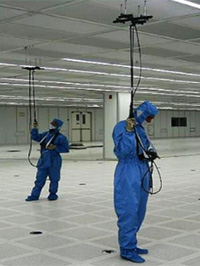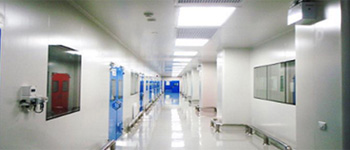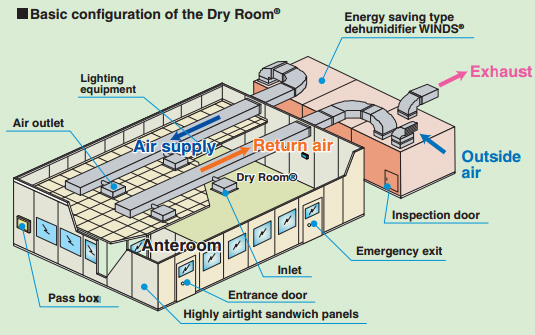Clean Room / Dry Room
Clean Room
| “Clean room” is a high technology which helps improving production quality, shortening a production process time which leads to a reduction of a production cost. |  |
 |
 |
What is Clean room? |
Here at Thai Takasago Co., Ltd. We offer various classes of Clean room that live up to client’s requirement, specifications and tasks. Thai Takasago Co., Ltd. has been operating for almost four decades, we are well-experienced and energy solution partner for your business. We have undergone uncountable projects in countless fields and designs. Clean room is one of Thai Takasago Co., Ltd.’s specialties.
It can be clearly seen that the purpose of Clean room is to clean. However, Clean room can be generalized in multiple purposes.
Clean room are classified by the cleanliness of their air. The method most easily understood and universally applied is the one suggested in versions of ‘Federal Standard 209’ up to edition ‘D’ in which the number of particles equal to and greater than 0.5 µm is measured in one cubic foot of air and this count is used to classify the room.
Within a room, there are particle-generating activities going on in the room, if the room is empty, very low particle concentrations can be easily achieved. Nevertheless, if the room is filled with production equipment in it and operating, there will be a greater particle concentration. This are the reasons why Clean room is classified in many classes.
Class of Clean room |
The classes of Clean room can be identified depending on the task of the industry. Identifying classes of Clean room should be considered thoroughly as the differences result in a big influence on cost. There are six classes of Clean room from Class 1 to Class 100,000 according to US FED STD 209E
Clean room Standards.
| ● |
Class 1 : These rooms are only used by integrated circuit manufacturers manufacturing sub-micron geometrics. |
| ● |
Class 10 : These rooms are used by semiconductor manufacturers producing integrated circuits with line widths below 2µm. |
| ● |
Class 100 : Used when a bacteria-free or particulate-free environment is required in the manufacture of aseptically produced injectable medicines. Required for implant or transplant surgical operations. Isolation of immunosuppressed patients, e.g. after bone marrow transplant operations. |
| ● |
Class 1,000 : Manufacture of high quality optical equipment. Assembly and testing of precision gyroscopes. Assembly of miniaturized bearing. |
| ● | Class 10,000 : Assembly of prevision hydraulic or pneumatic equipment, servo-control valves, precision timing devices, high grade gearing. |
| ● | Class 100,000 : General optical work, assembly of electronic components, hydraulic and pneumatic assembly. |
Dry Room = Drying Technology
Our drying technology, together with the latest equipment, now enables us to achieve the dew-point temperature of -100°C and that helps manufacturing lithium-ion battery, capacitor and organic EL. In addition,the technology has leading performance in energy efficiency.
Dry Room® technology |
Achieving low cost and energy efficient Dry Room® with appropriate device configuration and optimal operational control
Moisture in the air is an impediment for the manufacturing processes of the rapidly increasing rechargeable lithium ion batteries and organic EL. Their manufacturing is therefore performed in a Dry Room®, which has the moisture in the air removed in a controlled low dew point atmosphere. WINDS® is an original energy saving type dehumidifier which supplies dry air with a dew point temperature of -60°C. We use it to offer our low dew point Dry Room®, which achieves the highest level of energy conservation in the industry. The manufacturing cost for the dehumidifier air used in the Dry Room® is higher than for the conditioned air used in ordinary air conditioning. There are therefore increased demands for energy conservation in large scale mass production factories. In order to respond to there demands, we optimize the configuration of the dehumidification equipment to acheve reduced energy consumption and lower costs. Furthermore, we achieve further reduction in energy consumption by implementing optimal operation controls to deal with the periods when the dehumidification load is low, for example during the winter months.


